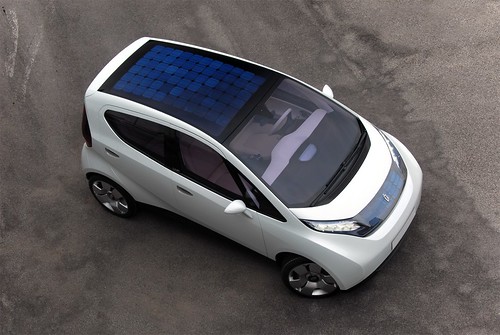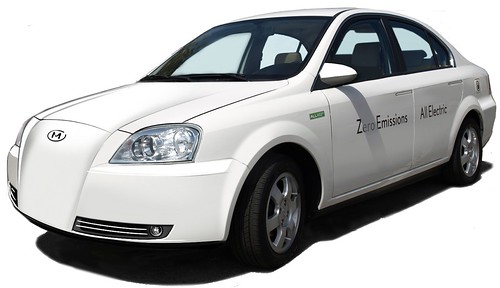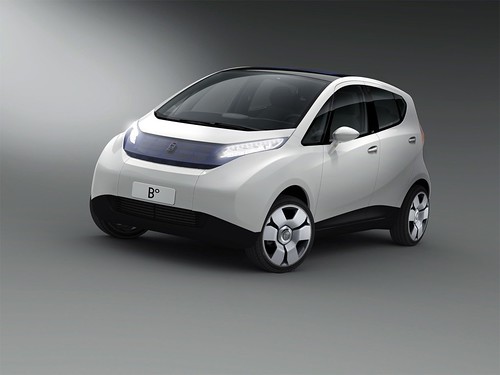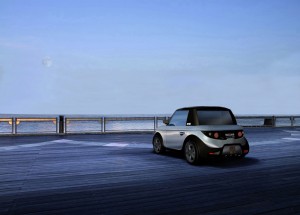Yet another Italian born, electric vehicle made its debut at the Paris Auto Show last month. This one has a 153-mile range and a top governed speed of 80 Mph. However, acceleration will be similar to its Italian competitor, the Tazzari Zero. Meaning, not very fast, 0-37 in 6.3 seconds. The advanced solar panels built into the roof only help power some of the cars equipment, but still look pretty darn cool:

Pininfarina teamed up with Bolloré to develop its electric power system. Bolloré is a highly diversified group of companies with a combined yearly turnover of 10 billion US dollars and 35,000 employees. For the past 30 years, the group has been the one of the world’s leading producer of components for capacitors. The lithium polymer battery is matched up with a supercapacitor that allows for excellent regenerative braking and acceleration capabilities and also extends the life of the battery to about 125,000 miles. The battery should be able to fully charge in only a few hours. The B0 is not a concept car or a prototype but an actual production model that will be built in Turin by the end of 2009. Go to Paninfarina’s B0 page for details.
Pininfarina B0 (to be pronounced B Zero) is dedicated to the memory of Andrea Pininfarina who was a firm believer in the project.
“To think, draw, design and build cars is not only an enthralling mental process.
Nor is it simply a business choice. It is also and above all a great social responsibility.”
Andrea Pininfarina (1957-2008)
The B0: the solution for a cleaner world
Bolloré and Pininfarina have entered into a partnership featuring all the expertise required to launch serial production of an electric car which, thanks to its technical characteristics and its attractive styling, is bound to make waves in motoring circles.
This car will not be a prototype. It will be a mass production model, with the first units coming off the production line at the end of 2009, after which production will be ramped up gradually based on the availability of the batteries. Built in Turin by Pininfarina-Bolloré, a joint venture formed by the two family-owned groups, the B0 electric car will be powered by Bolloré’s proprietary LMP technology, using a combination of batteries and supercapacitors manufactured in Bolloré’s plants in Quimper, France and Montreal, Canada. The B0 will be a fully-electric vehicle without any carbon dioxide production, having been designed from the ground up with that aim in mind. Its batteries will be housed in a compartment specially designed for that purpose and located under the car, between its axles, lowering its centre of gravity and providing it with outstanding road-holding properties.
With its superb body styled by Pininfarina, Italy’s renowned vehicle design shop, the B0 electric car will be an elegant four-seater, four-door hatchback with an automatic gearbox. Its LMP battery, which will be rechargeable in a matter of hours from a standard domestic main socket, will provide it with a range of 250 km (153 miles). The B0 will have a top speed that is electronically limited to 130 km/h (80 mph) and will feature potent acceleration, reaching 60 km/h from a standing start (0 to 37 mph) in 6.3 seconds. The B0 will also feature solar panels on its roof and hood, so as to help recharge its electrical power reserves.
Physical characteristics
Volume (litres) 300
Mass (kg) 300
Communication bus CAN
Electrical characteristics
Power rating 30 kWh
Nominal voltage 410 V
Peak power output 45 kW(30s)
Min. / max. battery voltage 300/435 V
Capacity at C/4 75 Ah
Energy density per unit mass 100 Wh/kg
Energy density per unit volume 100 Wh/l
Thermal characteristics
Internal temperature 60°C – 80°C
Operating temperature -20°C à + 60°C
LMP: revolutionary battery technology
At the heart of any electric car, lies the battery. Bolloré is a highly diversified group of companies with a combined yearly turnover of 10 billion US dollars and 35,000 employees. For the past 30 years, the group has been the world’s leading producer of components for capacitors. Thanks to its acquired know-how in extruded polymers and the storage of electrical energy, Bolloré has been working for 15 years through its subsidiary, Batscap, to develop a solid-state lithium polymer battery. This battery is able to store, weight-for-weight, and it can be recharged in just a few hours. The battery does not require any maintenance and has a lifespan of around 200,000 km (125,000 miles). Another key benefit is its unmatched safety while in operation. Added to that, the B0 electric car does not emit any exhaust gases, nor any fine particles. The car’s LMP batteries thus help combat air pollution. The batteries of the B0 also contribute to reducing noise, another nuisance which affects people’s quality of life in urban environments.
Supercapacitors: boosting acceleration and recycling power
Supercapacitors are sophisticated energy storage components developed by the Bolloré Group. In an electric car, supercapacitors draw and store energy generated while the car is braking and feed it back into the system when the car moves off again. The result is greater acceleration, increased range and a longer lifespan for the car’s battery. The electric cars powered by BatScap’s LMP batteries and supercapacitors have a range of over 250 km. They are fast (with a top speed of 130 km/h), pleasant to drive, safe, and long-lasting.
Natural energy from solar panels
Because it is 100% electric powered, the B0 does not generate any pollution. But the process of generating the electricity which the car uses must also, as far as possible, not have produced any atmospheric pollution. That is why the creators of the B0 have designed it to incorporate every possible solution designed to optimise the car’s energy efficiency and use of clean energy sources. For instance, the B0 electric car is fitted with supercapacitors, which enable it to store and recycle the energy that is generated while braking. Similarly, the car’s roof and part of its hood are covered with highperformance solar panels which help power some of its equipment. It goes without saying that a responsible environmental approach must be coherent throughout. Which is why all the materials used to build the car’s body, battery and interior trim have been carefully selected for their low environmental impact. All are recyclable or reusable. The Bolloré Group is also in the process of developing straight-forward panels of photovoltaic cells which might be installed by individuals or in public places to fully or partly recharge the B0 electric car’s batteries using solar energy.
The combined power of two major industrial groups
Ergué-Gabéric / Bolloré
LMP batteries and supercapacitors were developed at the research centre of the Bolloré Group’s production site at Ergué- Gabéric near Quimper in Brittany, France. They were the outcome of a concerted research effort founded on the Group’s core activities, Bolloré being the world’s leading producer of ultra-thin extruded films used in the production of capacitors, another energy storage component. The success of its research programme led the Bolloré Group to form BatScap, a subsidiary dedicated to these activities, some 15 years ago. Nowadays, BatScap’s employees have access to the most advanced laboratory and production facilities and comprise more than 120 engineers, research staff and technicians.
Montréal / Bolloré
In 2007, the Bolloré Group bought the assets of Avestor, the only other company in the world which possessed the technology and the patents required to manufacture LMP batteries. Avestor’s Canadian team, which numbers some sixty highly qualified staff, thus joined BatScap. By pooling the talent, technologies and facilities of both sites, the Bolloré Group is able to wield major and highly sophisticated production facilities which are ample to cater to the production lines of the B0 and electric Microbus vehicles.
Cambiano / Pininfarina
World-renowned for the talent of its design teams which have created many of the world’s most beautiful cars over the years, Pininfarina is also a highly experienced carmaker which produces high-end vehicles on contract for many makes. The B0 electric car will be produced by the Pininfarina-Bolloré joint venture at a plant located near Turin. The joint venture will benefit from the
tremendous know-how and experience of Pininfarina’s personnel, who are proud to be involved in producing the world’s first serial production electric car powered by LMP batteries and supercapacitors under the company’s own badge.
Two concrete examples of LMP batteries in use
La BlueCar
Designed from the ground up to take advantage of all the benefits provided by electric propulsion thanks to the highperformance batteries developed by BatScap, the BlueCar was created by Philippe Guédon, the designer of Renault’s first Espace vehicle, in cooperation with the Bolloré Group and Matra Engineering. The BlueCar is a compact vehicle that is ideal for driving around town. The first sketches for the BlueCar were drawn in the early 2000s. The car was exhibited at the Geneva Motor Show in 2005 and is now in its second version.
BlueCar vehicles have been driven for tens of thousands of kilometres in all traffic conditions, acting as a testbed for Bolloré’s LMP batteries, which were officially approved for use in motor vehicles in Autumn 2007. The BlueCar has served as a mobile laboratory for the soon-to-be-released serial production electric car and has demonstrated that electric-powered cars are not merely a distant utopia but a concrete prospect in our time.
The electric microbus
In parallel with its work on private vehicles, and in order to ensure that the benefits of electric motoring are extended to public transport, the Bolloré Group has formed a second joint venture with the Gruau Group, a maker of buses and coaches, to design and build an electric version of the Microbus. Uniquely suited to urban transportation, this attractively styled, diminutive bus (5.46 metres long) features tremendous accessibility and is able to carry up to 23 people. The all-electric version, powered by LMP batteries and supercapacitors developed by Bolloré, will provide a simple and effective option for local authorities to offer their constituents a means of public transport which is environmentally friendly.







